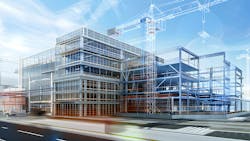Key Takeaways:
After reading this article, you should understand how Building Information Modeling (BIM) can …
- Enhance IOT interoperability
- Improve efficiency and reduce errors
- Facilitate communication and collaboration
- Support prefabrication for cost and sustainability gains
Smart construction is rapidly changing the way the industry operates. Firms hoping to remain competitive must capitalize on digital technologies, but doing so successfully means understanding which innovations are most worth the investment. Few single solutions offer as much value as building information modeling.
BIM has existed for decades, but its adoption and functionality have remained limited until fairly recently. Today’s software offers more features and advantages than ever, and construction companies can’t afford to overlook this potential. While all projects can benefit from BIM, smart buildings especially stand to gain from this technology.
Ensuring Smart System Interoperability
Clash detection—which automatically highlights design and workflow flaws—is a standard feature in modern building information modeling. Smart structures can benefit from this functionality more than most, as it can ensure Internet of Things (IoT) deployments are interoperable.
There are at least 21 distinct IoT connectivity standards, and not all smart systems support the same ones. Data formats and control mechanisms also vary. Consequently, architects and designers must ensure all of a building’s IoT infrastructure works together, but doing so can be challenging with so much variety.
Virtual models and automated clash detection let users simulate the environment to catch interoperability barriers before construction begins. They can then use the appropriate technologies to create a cohesive, interconnected smart building system.
Streamlining the Design Phase
Smart construction projects also need building information modeling for its efficiency. Only 8.5% of projects today finish on time and within budget. Extra complexity in a design—like adding IoT solutions—increases the likelihood of missed deadlines.
Modern BIM tools provide a suite of automated features. AI-powered design assistance can suggest changes, provide templates, or repeat steps to remove error-prone manual work. Real-time clash detection helps architects find and correct errors before lengthy redesigns become necessary.
BIM’s precision extends these benefits into the construction phase. Mistakes and rework are less likely when the final design features fewer errors. As a result, the project has a much better chance of wrapping up on time, even with the added complexity of installing IoT solutions.
Facilitating Communication
BIM also addresses communication issues. A worrying 59% of firm owners report frequent communication breakdowns between them and other stakeholders. BIM removes the barriers associated with conventional collaboration methods.
Many of today’s BIM solutions are cloud-based. Stakeholders can access the virtual model anytime from any device. The model will also update for all users whenever anyone modifies it, resulting in a single source of truth for everyone involved. Sharing digital files is as simple as sending an email, giving collaborators straightforward access to critical information.
Ease of communication is pivotal for smart building projects. Architects must collaborate with IoT specialists or other technical experts, requiring additional back-and-forth. Cloud accessibility makes cooperation admirably efficient, ensuring a smoother workflow and minimizing mistakes.
Expanding Prefab Opportunities
Building information modeling also lends itself to other Industry 4.0 innovations. Prefabrication is one of the most impactful. Modular projects have gained traction in construction for their efficiency and sustainability, and BIM makes them increasingly viable by making it easier to design with modularity in mind.
Architects can divide a BIM model into distinct units for prefabrication. These smaller models can then serve as the template for automated factory machinery, leading to exactly-to-specification prefabricated modules. AI BIM tools could also highlight which rooms are suitable for prefabrication and which require conventional methods.
Making modular construction more accessible has extensive benefits for the whole sector. Prefab can cut waste by up to 83.2% and minimize on-site timelines for faster project completion.
Enabling Digital Twins for Future Management
Similarly, BIM takes smart buildings to new heights by granting owners access to innovative digital tools. Once firms hand the project over to customers, they can give them the BIM model to serve as a digital twin of the building. This virtual representation can connect to the IoT systems throughout the property to streamline management.
Digital twins allow end users to get the whole picture of their smart building solutions and monitor their ongoing operations. This insight enables proactive maintenance and in-depth energy modeling. Property managers can also simulate various changes in the BIM model to find optimal renovation options.
Enabling such possibilities can set a construction firm apart from its competitors. Satisfied clients are more likely to become repeat customers, and helping clients save money is an excellent way to cement their loyalty.
Managing Smart Construction Costs
Finally, building information modeling is critical to smart construction because it offsets the costs. As beneficial as tech-centric approaches can be, they require high initial investments. BIM solutions make these expenses manageable by promoting cost-effectiveness throughout the project timeline.
Studies have found that BIM-driven smart construction can improve efficiency by 65%, shorten time to completion by 30% and boost labor productivity by 39%. Such massive operational improvements lead to significant financial savings. Applying similar gains to several projects can result in a much faster return on investment than attempting smart construction without BIM.
Of course, BIM is not free. However, software costs won’t be as high as the price of IoT solutions. Consequently, there’s a shorter payback period and a lower bar for entry. As a result, smart construction practices are accessible to a wider range of firms.
Smart Construction Needs BIM
The construction industry must embrace AI and the IoT, which introduces unique challenges. Building information modeling provides solutions to those obstacles.
Regardless of what other Industry 4.0 initiatives a firm pursues, it should build its efforts around BIM. The advantages are too significant to ignore, and failing to capitalize on them will limit the ability to maximize smart construction strategies.
Next Steps for Building Owners and Operators:
- Adopt BIM-enabled smart construction practices. Look for potential partners that integrate BIM into their workflows.
- Ensure IoT systems are interoperable. Take advantage of BIM’s clash detection to avoid costly integration issues.
- Use BIM for prefabrication opportunities. Leverage BIM technology to help reduce costs and construction waste through modular building strategies.
- Implement digital twins for better facility management. Connect your building systems to a BIM-based digital twin for real-time insights and optimization.
- Explore and invest in cloud-based BIM solutions. Help facilitate seamless collaboration between architects, engineers, and facility managers using a variety of BIM solutions.
- Calculate the ROI of BIM in your projects. Assess your cost savings, efficiency improvements, and long-term operational benefits before investing.
About the Author

Emily Newton
Emily Newton is an industrial and tech journalist passionate about how technology is revolutionizing each sector. She has been writing and editing professionally for more than five years and is the editor-in-chief of Revolutionized.
